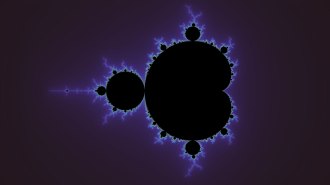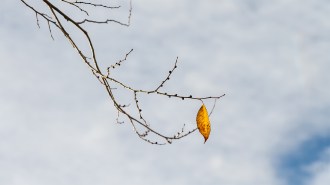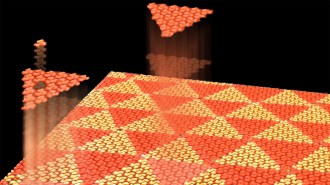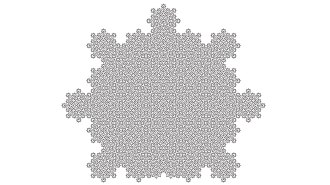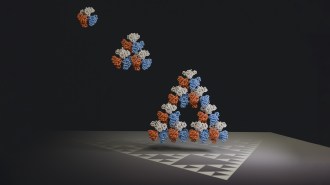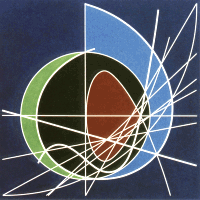
The term “mathematical art” usually conjures up just one name–that of Dutch graphic artist M. C. Escher (1898–1972). Many people are familiar with Escher’s endless staircases, hyperbolic tilings, Möbius ants, intricate tessellations, and other creations. They may also be aware of the intertwining of mathematics and art during the Renaissance, with the development of perspective painting and eye-teasing stagecraft.
But the realm of mathematical art is far wider and more diverse than most people realize. A surprising number of contemporary artists count mathematics–from Fibonacci numbers and the digits of pi to tetrahedra and Möbius strips–as the inspiration for their creations.
For those fortunate enough to be in New York City, the Art & Mathematics 2000 exhibit offers a rich sampling of artworks inspired by mathematics, ranging from the gracefully curved sculptures of Brent Collins and tensegrity structures of Kenneth Snelson to the playful polyhedra of George Hart and the wavy painted grids of Doug Pedens.
The show runs from Nov. 7 to Dec. 15, 2000, at the Cooper Union for the Advancement of Science and Art, Humanities Gallery and Brooks Design Center, Albert Nerken School of Engineering, 51 Astor Place, New York City (http://www.cooper.edu/engineering/Welcome.html).
“A work of art is the demonstration of an idea represented through form, line, color, and value,” says New York City artist and exhibit curator Clifford Singer, whose own paintings reflect classical geometric theorems. “Rarely has such harmony been brought together than in this exhibition.”
Clifford Singer, Continuity, 1999, acrylic on plexiglass, 36 x 36 inches. |
The show features artworks by the following people:
- Manuel A. Baez and Jean Le Mée, Cooper Union
- Bob Brill (http://users.migate.net/~bobbrill/ and Scrambled Grids, Aug. 26, 2000)
- Benigna Chilla (http://www.wahcenter.org/exhibits/2000/yaddo/Chilla.jpg and http://www.emis.de/journals/JGG/1.2/7.html)
- Brent Collins (http://www.cs.berkeley.edu/~sequin/SCULPTS/collins.html, http://www.cs.berkeley.edu/~sequin/SCULPTS/scherk.html, and Sculpture Generator, Oct. 2, 1999)
- Agnes Denes (http://asci.org/artsci99/denes.html
- Mike Field (http://nothung.math.uh.edu/~mike/)
- Nat Friedman (http://www.albany.edu/~artmath/)
- Charles Ginnever (http://www.briangrossfineart.com/artists/cginnever/.
- Bathsheba Grossman (http://www.bathsheba.com/)
- Susan Happersett (http://www.purgatorypiepress.com/artistsbooks_files/boxofgrowth.htm and Möbius Accordion)
- George W. Hart (http://www.georgehart.com/)
- Robert Longhurst (http://www.cs.berkeley.edu/~sequin/SCULPTS/LONGHURST/ and A Minimal Winter’s Tale, Feb. 5, 2000)
- Clement Meadmore (http://www.yaddo.org/Yaddo/OnsiteMeadmore.shtml, http://www.qc-art.com/html/meadmore.html, and http://www.pyramidhill.org/main/1999Aug31220527.shtml)
- Eleni Mylonas (http://www.elenimylonas.com/)
- James C. Norman
- Douglas D. Peden (see Art of the Grid, Aug. 12, 2000)
- Charles O. Perry (http://www.charlesperry.com/, http://www.cs.berkeley.edu/~sequin/SCULPTS/PERRY/, and Möbius at Fermilab, Sept. 2, 2000)
- George Rickey (http://www.davidsongallery.com/rickey.html, http://www.decordova.org/decordova/sculp_park/rickey.html, http://www.nga.gov/feature/sculptgarden/sculpt13.htm, and http://www.stormking.org/GeorgeRickey.html)
- Tony Robbin (http://tonyrobbin.home.att.net/)
- Carlo Séquin (http://www.cs.berkeley.edu/~sequin/)
- John Sharp (http://www.mathsyear2000.org/resources/slice/)
- Arthur Silverman (Art of the Tetrahedron, Nov. 6, 1999)
- Clifford Singer (http://math.rice.edu/~joel/NonEuclid/singer/, and http://members.tripod.com/vismath/clif/index.html)
- Kenneth Snelson (http://www.kennethsnelson.net/.)
- John Sullivan (http://www.math.uiuc.edu/~jms/)
Several of these exhibition participants will take part in an art and mathematics symposium on Nov. 11, 1-5 p.m., at the Cooper Union’s Driscoll Auditorium.
In commenting on the immense scope of mathematics, the 19th-century British mathematician James Joseph Sylvester (1814–1897) remarked, “Its possibilities are as infinite as the worlds that are forever crowding in and multiplying upon the astronomer’s gaze.”
The same can be said of the unlimited scope of imagination, whether in mathematics, art, or everyday life.
